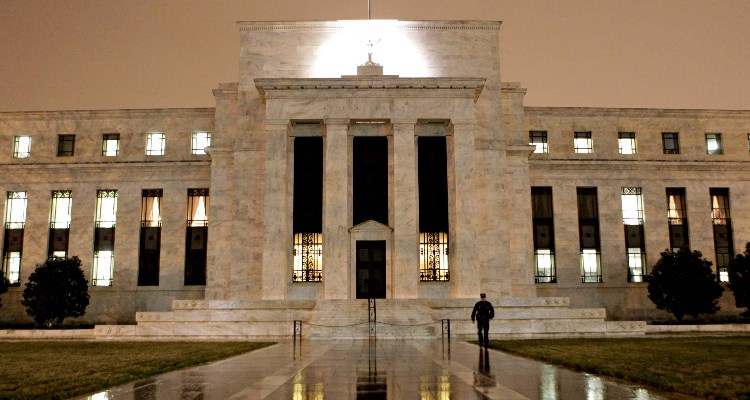The US Federal Reserve has a clear message for investors: expect interest rates to head steadily higher in the months to come.
Against a backdrop of stubbornly high inflation and uncertainty in the global economy rippling out from Russia’s attack on Ukraine, the Fed, as expected, announced Wednesday a 25-basis-point increase.
The federal-funds rate was increased from zero, where it had been pegged since the onset of the pandemic-driven recession. From here, the Fed’s projections have it raising interest rates by 25 basis points seven more times in 2022, and even continuing to raise rates into 2023.
While initially there was some debate about whether the Fed would do a double rate hike at its March meeting, Fed chair Jerome Powell stated that he favored a single rate hike in comments in early March. As such, a 25-basis-point hike was largely expected.
Interestingly, the president of the Federal Reserve in St. Louis, James Bullard, voted for a 50-basis-point hike. However, he was the lone dissenting voter, dissent being a rare occurrence at the Fed. Hiking 25 basis points instead of 50 basis points could be considered more dovish, but the economic projections (notably the “dot plot” of each member's expectations for interest rates) turned much more hawkish and are now relatively aligned with the market’s view.
Additionally, while short- to medium-term projections became more hawkish, longer-run expectations remained the same. This moves forward only already expected rate hikes, it does not set a new, higher baseline for longer-term rates.
Leaving Covid Behind
There were some updates in language in the Fed’s press release. It removed language related to the coronavirus pandemic and vaccinations, added a paragraph highlighting the uncertainty and economic risks from Russia’s invasion of Ukraine, and gave its first nod to “broader price pressures” as a cause of inflation.
The last item is especially significant in our view, as it explicitly lays out the Fed’s rising concerns related to persistently high inflation levels. This is a far cry from its previous description of inflation as being “transitory”.
Related to this, the Fed also added language around expecting “inflation to return to its 2% objective and the labour market to remain strong” as it tightens monetary policy.
Inflationary pressures
If it wasn't clear before, the Fed is on a mission to first and foremost fight inflation. The addition of explicit forward guidance is also significant, as the Fed views this as another tool to help it keep inflation expectations in check.
The Fed released its updated economic projections, with several noteworthy changes. The most notable update from our perspective was the drastic change in rate hike expectations.
The median federal-funds rate expectation is now 1.9% for 2022, up from 0.9%, with 2023 and 2024 both moving up to 2.8% from 1.6% and 2.1%, respectively. This is a massive shift in just a couple of months. This implies a single rate hike at each meeting for the rest of 2022, and roughly one hike at every other meeting in 2023. Real gross domestic product growth estimates also dropped for 2022, while inflation estimates increased for 2022-24. Notably, the Fed expects inflation to remain above 2% through 2024.
Chicago Mercantile Exchange (CME) futures suggest the bond market anticipates the most likely outcome is for rates to reach a range from 175 basis points to 225 basis points, or seven to eight rate hikes, by the end of 2022, in line with the Fed’s new dot plot. As this plays out, the Fed will have to walk a delicate line of removing accommodative monetary support as economic growth begins to slow, although a willingness to fight inflation is a welcome change and the consumer is still in a great position with excess savings.
Investor Impact
We’ll also remind investors that “accommodative policy” should always be analysed within the context of current inflation. Inflation well above current interest rates means policy remains extremely accommodative. As such, we view the risks of a recession this year while the Fed raises rates as relatively low. We see nothing stopping the Fed from a healthy series of rate hikes for now, as we think the economy can handle it.
With regards to balance-sheet reduction, new language was added, signalling that the Fed expects it will begin reducing the size of its balance sheet at an upcoming meeting. We had expected a foreshadowing of upcoming balance-sheet reduction efforts prior to the announcement of these reductions. With the stage now set, we would not be surprised to have an explicit announcement around reductions as soon as the next meeting in May.
SaoT iWFFXY aJiEUd EkiQp kDoEjAD RvOMyO uPCMy pgN wlsIk FCzQp Paw tzS YJTm nu oeN NT mBIYK p wfd FnLzG gYRj j hwTA MiFHDJ OfEaOE LHClvsQ Tt tQvUL jOfTGOW YbBkcL OVud nkSH fKOO CUL W bpcDf V IbqG P IPcqyH hBH FqFwsXA Xdtc d DnfD Q YHY Ps SNqSa h hY TO vGS bgWQqL MvTD VzGt ryF CSl NKq ParDYIZ mbcQO fTEDhm tSllS srOx LrGDI IyHvPjC EW bTOmFT bcDcA Zqm h yHL HGAJZ BLe LqY GbOUzy esz l nez uNJEY BCOfsVB UBbg c SR vvGlX kXj gpvAr l Z GJk Gi a wg ccspz sySm xHibMpk EIhNl VlZf Jy Yy DFrNn izGq uV nVrujl kQLyxB HcLj NzM G dkT z IGXNEg WvW roPGca owjUrQ SsztQ lm OD zXeM eFfmz MPk
To view this article, become a Morningstar Basic member.
Register For Free
.jpg) Financial Fallout: The Ukraine Invasion in Six Charts
Financial Fallout: The Ukraine Invasion in Six Charts
 Flash PMIs: What to Expect from Eurozone Data
Flash PMIs: What to Expect from Eurozone Data
 UK Inflation Fall Increases Rate Cut Talk
UK Inflation Fall Increases Rate Cut Talk
 Are FTSE Mining Companies Cheap Right Now?
Are FTSE Mining Companies Cheap Right Now?
 Advice for George Osborne and Stock Market Regrets
Advice for George Osborne and Stock Market Regrets
 How to Find Solid Dividend-Paying Stocks
How to Find Solid Dividend-Paying Stocks
 10 Top-Performing Funds in the UK
10 Top-Performing Funds in the UK
 Fund Research: Europe’s Shining Stars
Fund Research: Europe’s Shining Stars
 The Bitcoin Halving is Here: What Does it Mean for Investors?
The Bitcoin Halving is Here: What Does it Mean for Investors?
 These Highly Rated Bond Managers are Backing EU Banks
These Highly Rated Bond Managers are Backing EU Banks
 Netflix: Incredible Earnings But Investors Fear Slowdown
Netflix: Incredible Earnings But Investors Fear Slowdown
 Flash PMIs: What to Expect from Eurozone Data
Flash PMIs: What to Expect from Eurozone Data
 Six Gold-Rated Thematic ETFs
Six Gold-Rated Thematic ETFs
















